How have London's museums been doing since they reopened?
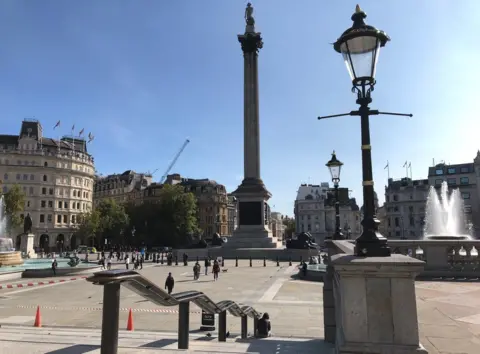 BBC
BBCIt has been three months since the UK's museums and galleries could reopen their doors after several months of lockdown.
At the time, London's biggest institutions predicted social distancing and the loss of international tourists would cut visitor numbers by 80%.
So how have the capital's museums found reopening and can they survive the pandemic?
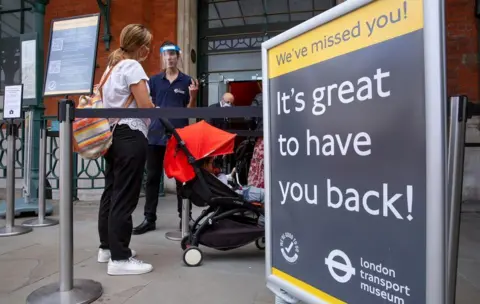 London Transport Museum
London Transport MuseumThere's a distinct lack of bustle around central London at the moment. While all areas are quieter than usual, some have been hit particularly hard.
Fortunately for the London Transport Museum, Covent Garden appears to be one of the busier spots.
"We're on about 40% of the same weeks last year... our weekends are busy and we're even starting to push the capacity we're allowed with social distancing," said chief executive Sam Mullins OBE.
The museum opened at the start of September, and Mr Mullins said it had been "pleasantly surprised" by the numbers turning up.
The online shop is also 40% up on 2019, and initiatives such as a quiz night hosted by London Transport Commissioner Andy Byford are bringing in new people.
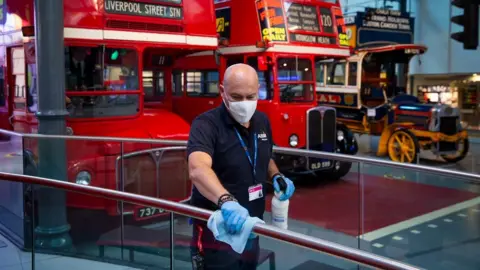 London Transport Museum
London Transport MuseumNevertheless, Mr Mullions said it "couldn't carry on like this for very long".
Expenses including a monthly rent of £74,000 means it costs £25,000 to open each day, and with 80% of income having to come from earnings such as ticket sales, the figures are not adding up.
The museum is now waiting on a £1.75m bid from the £1.57bn emergency support package, the results of which are being announced over the next few weeks.
"We're holding our breath on that. If we don't get it I think we're going to be in dire straits," said Mr Mullins.
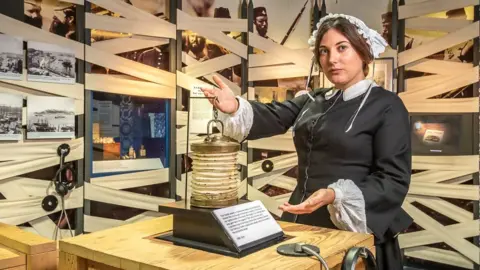 Florence Nightingale Museum
Florence Nightingale MuseumLife is quieter over the River Thames opposite the Houses of Parliament where the Florence Nightingale Museum is based. Indeed, director David Green describes it as "pretty bleak".
The museum, with its exhibition marking the Lady with the Lamp's bicentenary, opened on 1 August.
"Everybody that's come has said it's a fantastic experience... however, 'everybody' is just not enough," Mr Green said.
Some 98% of the museum's income comes from ticket sales and retail. However, 70% of the museum's visitors tend to be foreign tourists.
School trips are also important for the museum's finances and there would normally be about two or three groups visiting every day during term time.
"We've got four school bookings now until April. That's absolutely devastating for the business," said Mr Green.
He said people's fears about having to travel into central London on public transport were also playing their part.
As a result the museum is now considering mothballing the site and employing only a skeleton staff "to retain and look after the collection and give us time to think".
"I don't know if and when we'll make the decision, but being honest we can only sustain this for so long," said Mr Green.
 The Postal Museum/Miles Willis
The Postal Museum/Miles WillisThe Postal Museum in Mount Pleasant did not open following the government's announcement in June. Instead it announced only his week that the venue and its Mail Rail attraction would start running on 29 October.
"Not all museums are the same," said chief executive Laura Wright. "It made financial sense for us to stay closed and take advantage of the furlough system while central London remains so quiet."
During that time it has run activities such as tunnel walks which Ms Wright said had given it some optimism for later in the year.
She said: "There's been a huge appetite for them. They sold out incredibly quickly and people have come and said they're so grateful to us that we've been there."
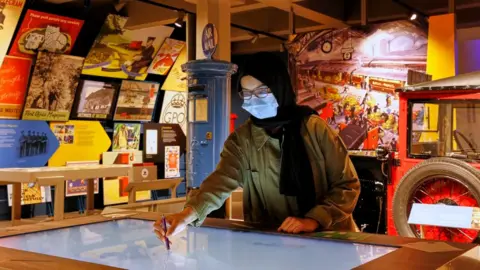 The Postal Museum
The Postal MuseumBeing a relatively new institution, the museum has concentrated on building a strong local audience rather than appealing to international tourists.
It is not as heavily seasonal as other attractions, with periods such as school half-terms and Christmas tending to be busy times, meaning "we're not going to miss our biggest time of the year".
"We do need money now... This is a really vibrant sector and will be again but the centre of London is just really suffering," Ms Wright said.
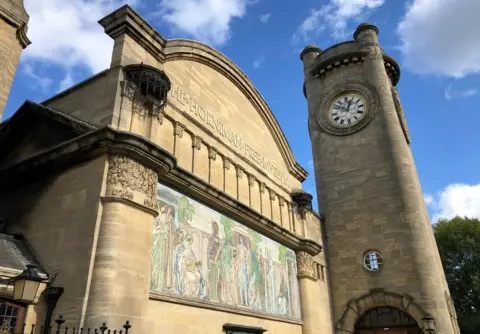
The Horniman Museum and Gardens is based out of the centre of London in Forest Hill. Chief executive Nick Merriman said: "Our visitors are mostly local.
"About 70% come from local boroughs or Kent and Surrey and we have huge numbers of repeat visitors."
The museum is getting up to 35% of normal visitor numbers, but Mr Merriman said it had reached maximum capacity "several times".
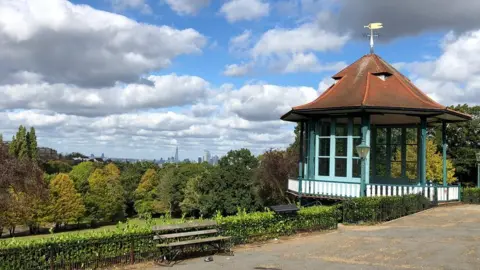
The Horniman receives most of its income from the government and Arts Council England, which Mr Merriman believes has been an advantage.
Yet he thinks the pandemic will bring lasting changes for the museum sector with focus shifting to providing "a good experience to a wider range of people", not just chasing visitor numbers.
"We can't pretend things will go back to what they were. The model for constant growth is not possible and has been exposed for being fragile and unsupportable," he said.
As for those museums which need to make money from ticket sales, the Association of Independent Museums believes these can eventually bounce back but it will take time.
"There will be losses of staffing and expertise. These can be reversed, but it could take years to get there," the association's chairman Andrew Lovett said.
What about London's largest museums?
 Reuters
ReutersInstitutions such as the British Museum and V&A are sponsored by the Department for Digital, Culture, Media & Sport and do not charge people to visit their permanent collections.
Government figures show combined visits to these venues peaked at the end of August at 25% of normal visitors, but have since fallen back to about 20%.
The Natural History Museum said it had been "pleased with visitor numbers given the restrictions", while the Imperial War Museum said it had "exceeded our visitor figure targets".
Sir Ian Blatchford, director of the Science Museum, said visitors had returned "in greater numbers than expected over the summer, with 30% of our usual figures in the first few weeks".
However, he added that "it is clear we face a challenging winter".
Indeed, some places such as the Tate art galleries have already announced job losses, while the Museum of London, which receives most of its money from the City of London and Greater London Assembly, is planning to cut about 10% of its museum staff.
